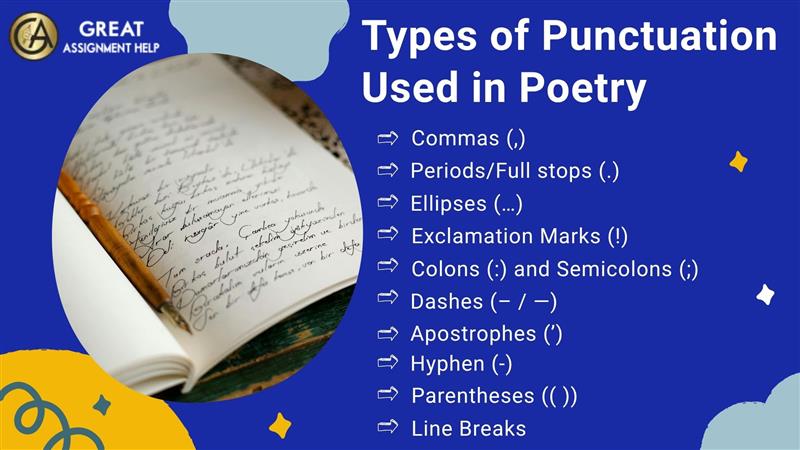Punctuation in poetry enables the poet to deliver the original meaning and tone. Also, it assists the readers in following the rhythm and sentiment of the poem. With punctuation, writers can develop a rich reading experience.
Emily Dickinson was a renowned poet famous for her unconventional writing style. She employed dashes rather than conventional punctuation and did not adhere to usual capitalization conventions. This was unlike most authors of her time. Even to this day, she continues to attract readers and scholars because of her interesting style. Furthermore, it demonstrated how a change in punctuation could alter the interpretation of, as well as our emotions towards, a poem. If you want to know about punctuation in poetry, then go through this blog. In this blog, we have discussed the various types of punctuation along with punctuating a poem.
What is a Poem?
A poem is more than words. A poem is usually a means of expressing human feelings and experiences. Poems cannot be defined in any one way, but poems usually take complex thoughts and feelings and place them within a structured format. This makes poetry an excellent topic for analysis. Yet, within a poem, small things such as punctuation will alter the way a reader senses and perceives the work.
Here, let us see the examples of some poets and their poetry writing style:
- Poets such as Emily Dickinson employ plain yet strong language to discuss broad subjects like death and nature. For instance, in her poem “Because I could not stop for Death,” she talks about mortality calmly.
- Some poets, such as William Shakespeare, have a special poetry structure and form. His Sonnet 18 is an excellent representation of it. In Sonnet, he employs a conventional structure with particular rhyme and meter to contrast the beauty of someone he loves with a summer’s day.
- Certain poets make use of poems as an effective tool to tackle serious matters. Langston Hughes’ poem “Harlem” wonders what becomes of dreams deferred, and encourages readers to consider the repercussions of unrealized hopes. Additionally, his words convey strong feelings and resonate with readers at a profound level.
Types of Punctuation Used in Poetry

In poetry, punctuation affects the tone, rhythm, and meaning. So, poets will choose punctuation carefully to improve their work and create a better reading experience. The following are some common types of punctuation in poetry you should be aware of to understand a poem
- Commas (,): These are small pauses that will help you understand the poem better and separate items in a list.
- Periods/Full stops (.): It will show the end of a thought or sentence.
- Ellipses (…): It will create a pause, mystery, or suggest something is left out. It will make you think more deeply.
- Exclamation Marks (!): It will show strong feelings, excitement, or urgency in a poem.
- Colons (:) and Semicolons (;): It is not used often in poems, but they can connect ideas or show contrast between them.
- Dashes (– / —): En dashes will link things; em dashes will interrupt or add emphasis. Overall, both can add drama or show sudden changes.
- Apostrophes (’): It is used for showing ownership or shortening words. Typically, it will make poems feel personal or casual.
- Hyphen (-): It combines two words to make a new idea.
- Parentheses (( )): It will add extra thoughts or side comments, like whispers inside a poem.
- Line Breaks: It is very important in poems for rhythm and how the poem looks. Moreover, it can change meaning and make you pause.
Understand How to Punctuate a Poem
If you want your poem to be powerful and easily understandable for your readers, then properly use the punctuation. In case you are unsure how to punctuate a poem, follow the tips suggested below. Here, we have also shared some examples to help you improve your understanding of how to choose the right punctuation and use it well.
End Marks
It shows when a sentence ends. Generally, end marks will help readers understand when a thought is finished.
These are some main end marks poets use in poetry
Period (.): It is often used at the end of a regular sentence or a command.
Example- “To be or not to be, that is the question.” – William Shakespeare, Hamlet.
Here, the period ends the sentence and makes it feel final and serious.
Question Mark (?): It is generally used at the end of a question.
Example – “Do I dare disturb the universe?” – T.S. Eliot, The Love Song of J. Alfred Prufrock
It shows the speaker is unsure and makes the reader think.
Exclamatory Mark (!): It shows strong feelings like surprise or excitement.
Example – “Because I could not stop for Death – He kindly stopped for me – The Carriage held but just ourselves – And Immortality!” – Emily Dickinson
Here, the exclamation adds emotion and highlights the mystery of the moment.
Capitalization
Capitalization means starting certain words with an uppercase letter. Poets use capitalization to highlight important things like names, new sentences, or titles. The following are the standard capitalization rules that poets use while writing poems
Proper Nouns: In a poem, the names of people, places, or special things should always start with a capital letter.
Example – “Alice fell down the rabbit hole into Wonderland.” – Lewis Carroll
“Alice” and “Wonderland” are names, so they start with capitals.
Beginning a Sentence: The first word of a sentence should start with a capital letter.
Example- “It was the best of times, it was the worst of times.” – Charles Dickens
“It” starts the sentence, so it is capitalized.
Titles: In titles, capital letters should be used for the first and last words, and the most important words in between.
Example: “The Old Man and the Sea” – Ernest Hemingway
The title stands out more with these words capitalized.
Comma (,)
Commas are small breaks in a sentence. Poets use it to separate ideas and make the meaning clearer.
Example: “Sing in me, Muse, and through me tell the story of that man skilled in all ways of contending.” – Homer, The Odyssey
Here, the comma adds a pause. Also, it shows the speaker is calling out to the Muse before telling the story.
Dash (– / —)
Dashes can break up a sentence to add drama or focus on a certain part. The dashes are of two types
En dash (–): It connects words.
Em dash (—): It breaks up a thought or adds a strong pause.
Example: “Do I dare — Disturb the universe?” – T.S. Eliot
Here, the em dash adds hesitation and makes the reader pause.
Semicolon (;)
Semicolons link two complete thoughts that have a close connection. They make the pause stronger than a comma but weaker than a full stop.
Example: “To be or not to be; that is the question.” – William Shakespeare
Here, the semicolon connects the ideas while keeping them separate.
Apostrophe (’)
Apostrophes are generally used to show possession and make contractions.
Possession: It denotes who something belongs to
“O, Romeo’s heart, be steady as you go.” – William Shakespeare
Here, the apostrophe shows the heart belongs to Romeo.
Contraction: It refers to shortened words
Example: “It’s a tale of love and tragedy.”
“It’s” is short for “it is.”
Compound Sentence
Compound sentences have two or more full ideas joined by a word like and, but, or a semicolon. Punctuation helps keep the sentence clear and smooth.
Example: “He gives his harness bells a shake to ask if there is some mistake.” – Robert Frost
This sentence has two connected thoughts that flow together. Also, it shows both action and thought.
Conclusion
Hopefully, by now, you will have gained an understanding of how to use punctuation in a poem. If you still have doubts about punctuation in poetry, hire a literature assignment helper from our team. Our professionals will clarify your doubts and improve your understanding of the subject. Moreover, you can also utilize our expert English assignment help services if it is challenging for you to write homework that is related to poetry.



